
Rediscovering Japan

Rediscovering Japan
Travel (Wakayama/Mie Part 2 (Kumano))

by tomizuta
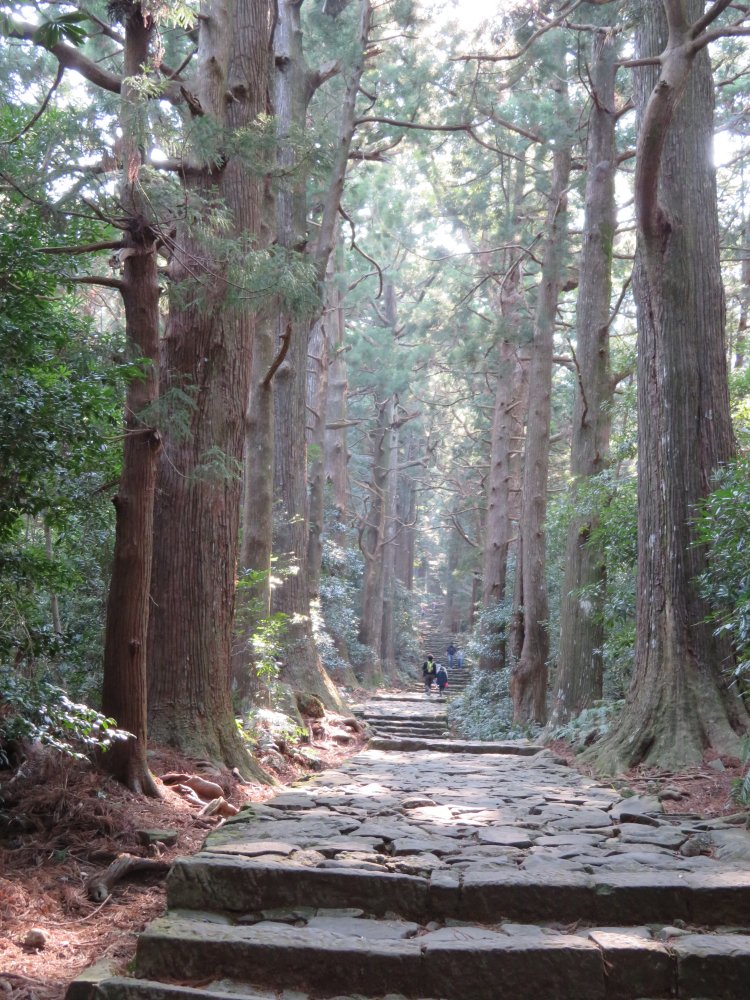
The well preserved pilgrimage route leading up to Nachi-taisha
The Sacred Sites and Pilgrimage Routes in the Kii Mountains, designated as a World Heritage site in 2004 is composed of three main sacred sites, Yoshino and Omine, Kumano Sanzan and “Koyasan. Following Ise Jinguu, we went on to visit Kumano Sanzan (the three sacred shrines of Kumano), Kumano Honguu Taisha, Kumano Hayatama Taisha and Kumano Nachi Taisha. There is a saying “Seven times to Ise and three times to Kumano”. This is a recommendation to encourage pilgrimage to the sites. Worship of these sites was promoted by people called Oshi or nuns called Bikuni. Although the saying seems to indicate that close to a million a year visited Kumano if we accept that there were two million visiting Ise in the Edo era, I would assume the real number must have been much smaller, as the sites are located deep in the forests and it is understood that there were many that collapsed before they could complete the pilgrimage.
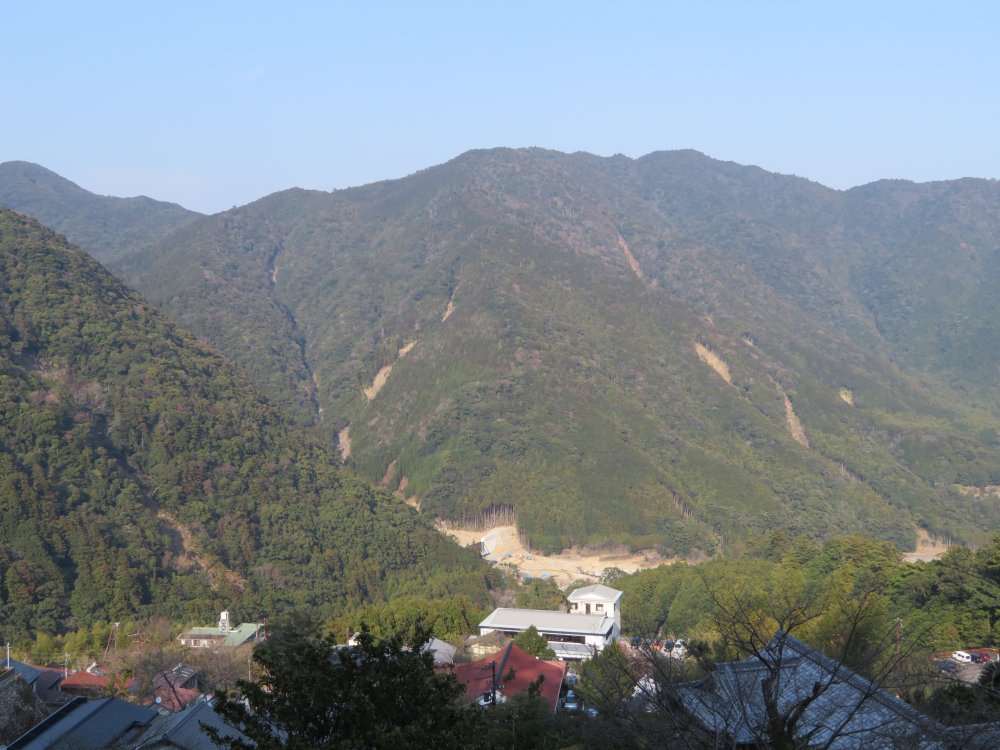
View of the densely forested Kii Mountains from Nachi-taisha
I do not wish to be too academic as to why the Kii (old name for the Wakayama
Prefecture area) mountains, which is a range of mountains 1,000 to 2,000
meters above sea level, densely forested with many waterfalls, became one
of the most sacred places in Japan. What one needs to know about is first
the ancient belief that Gods dwell in the mountains, waterfalls, huge boulders
and other natural objects. The Kii Mountains were considered to be the
place where prominent Gods dwelt, as can be seen by how Ise Jinguu which
is not far away was the place selected as the permanent shrine for Goddess
Amaterasu. Buddhism was imported to Japan in the 6th century, and in the
early 9th century a Buddhist Priest Kuukai established the Shingon sect
of esoteric Buddhism. Shingon means “true word”. Kuukai encouraged the
pursuit of the true word through spiritual training and stoicism and selected
Kouyasan as the ideal place to pursue this and founded Kongoubuji Temple.
I will explain further on Kouyasan in a separate article. Later in the
11th century, there was a belief that we were reaching the end of the world
leading to a search for Paradise (Joudo) where people could be greeted
by Buddha. Some believed that this Joudo existed in the Kii Mountain range
or further south in the Pacific Ocean. All these beliefs were blended into
a unique Shinto and Buddhism fusion, as we will see later.
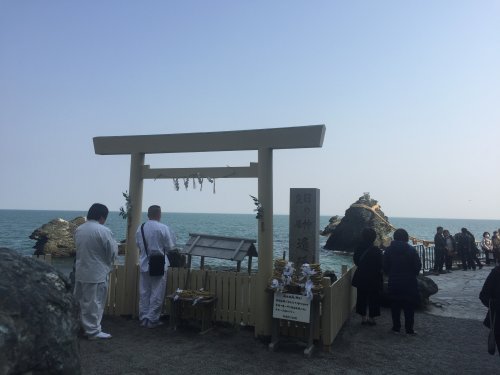
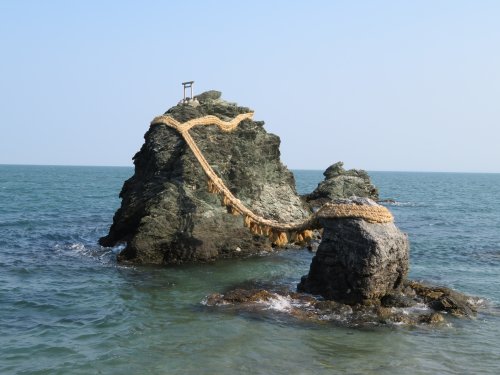
Pilgrims praying in front of Meotoiwa. Meotoiwa (husnand and wife rock) is the Shinto gate to a sacred boulder 600 meters further out in the sea, where God Sarutahiko supposedly transcended.
The three sacred sites of Kumano Sanzan are all along the River Kumano, which itself is a component of the World Heritage designation. The river originates in the Mount Omine area and runs south and then briefly north east for about two hundred kilometers. We first visited the Kumano Hayatama-taisha located at the river mouth in Shinguu City, which developed as the monzenmachi of Hayatama-taisha as well as a trading center for lumber transported down River Kumano from the Kii mountains.
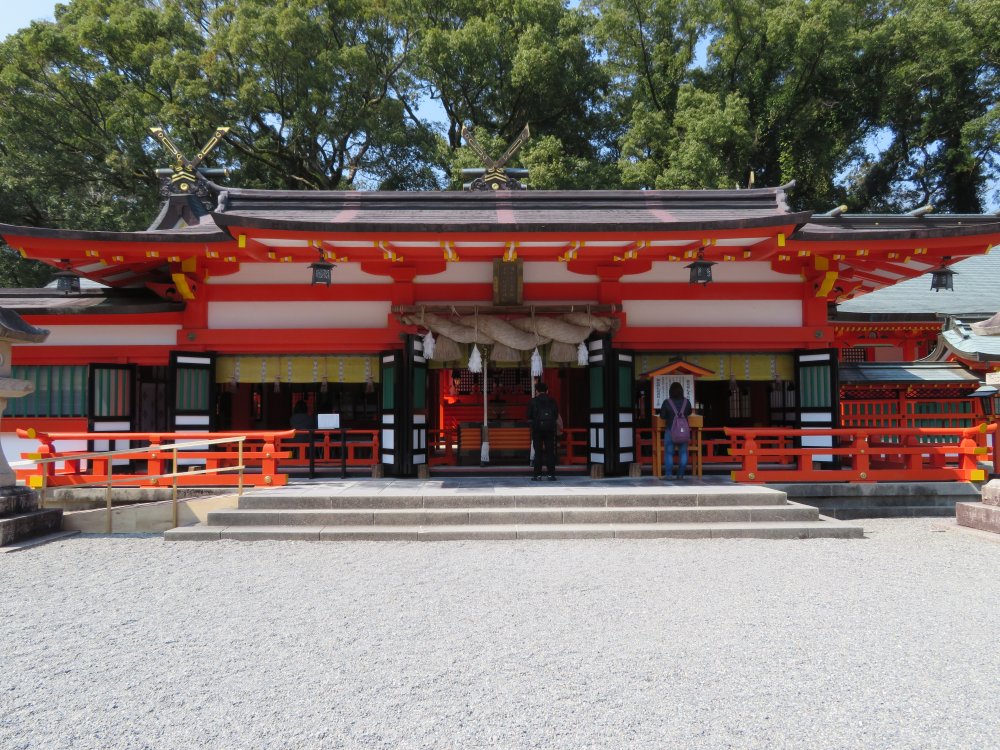
Visitors pray in front of the altar of Hayatama-taisha. Note the symbols on the roofs of the shrines in the back. The horizontal one is of a Goddess (Izanami) and vertical of a male God (Izanagi).
Hayatama-taisha is located in Shinguu City (Wakayama Prefecture) on the eastern coast of Kii peninsular and on the southern side of the river mouth of River Kumano. The other northern side of the river belongs to Mie Prefecture. Behind Hayatama-taisha is Mount Kamikura which is only 100 meters high and hosts a big boulder called Gotobukiiwa. Kamikura appears in Japan’s oldest chronicle Nihonshoki which mentions a visit of the mythical first Emperor Jinmu to Kamikura. Kamikura was believed to be where the Gods of Kumano descended from heaven and the boulder Gotobikiiwa was an object of worship. The website of Hayatama-taisha says that it originated in Kamikura and was relocated to the current site in the reign of the 12th Emperor Keikou (probably around the 4th century). Hence it was regarded as Shinguu (new shrine) from which the name of the city derives. The name Hayatama-taisha first appears in an index of Shinto Shrines composed in the 10th century. The shrine is dedicated to the Gods Hatayama and Fusumi, who are also believed to be God Izanagi and Goddess Izanami, the parents of Goddess Amaterasu. There is a sacred Nagi tree, a species of pine, in the shrine grounds. Our guide advised us that the leaves have no veins and is difficult to tear. So many put a leaf in their purses so that money will not dry up easily (In Japanese “tear” can also mean “dry up”) or as a token at a wedding wishing that the relationship will not be torn.
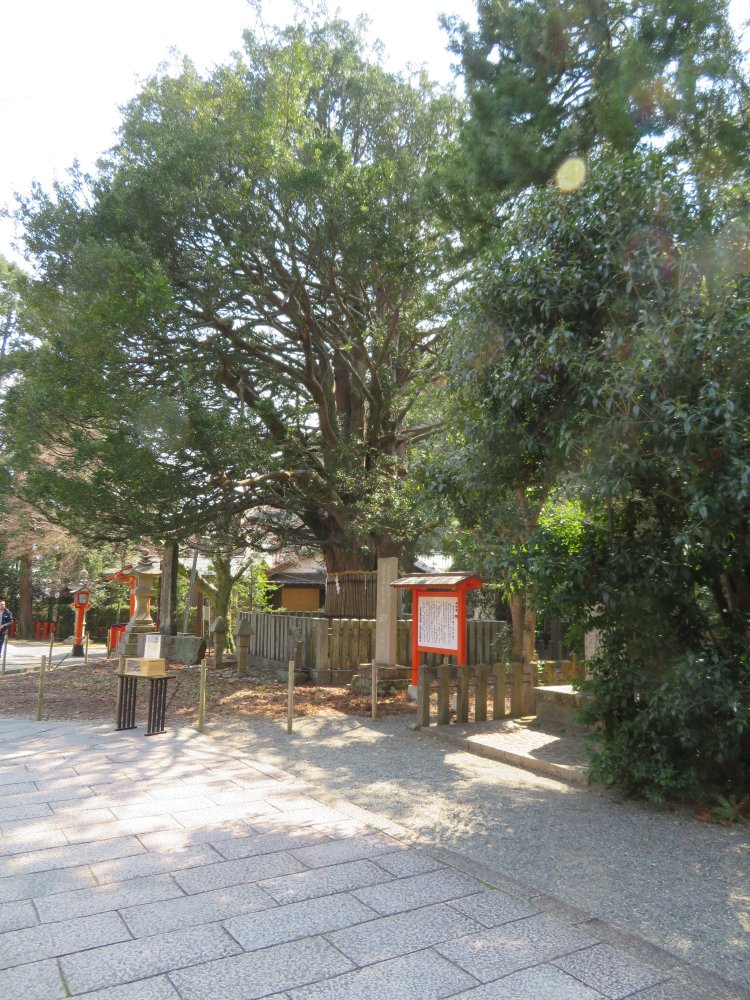
The Nagi tree in Hayatama-taisha
The travel route from Kyoto to Kumanosanzan was to go to Osaka by boat down River Yodo, then south along the western coast of Kii Peninsular to Tanabe. From Tanabe there was a route to the west linking the three sacred shrines of the Kumano Sanzan called Nakahechi. Particularly in the 11th to 13th century, many retired Emperors made pilgrimage to the Kumano Sanzan using the Nakahechi route. As there are limited access routes in the mountainous and densely forested area, a lot of what had been part of the Nakahechi route has been converted into modern roads. The 600 meters route leading up to Nachi-taisha from Daimonzaka is one of the most well preserved pilgrimage paths on the Nakahechi route. From Hayatama-taisha our bus drove 30 minutes to take us to Daimonzaka.
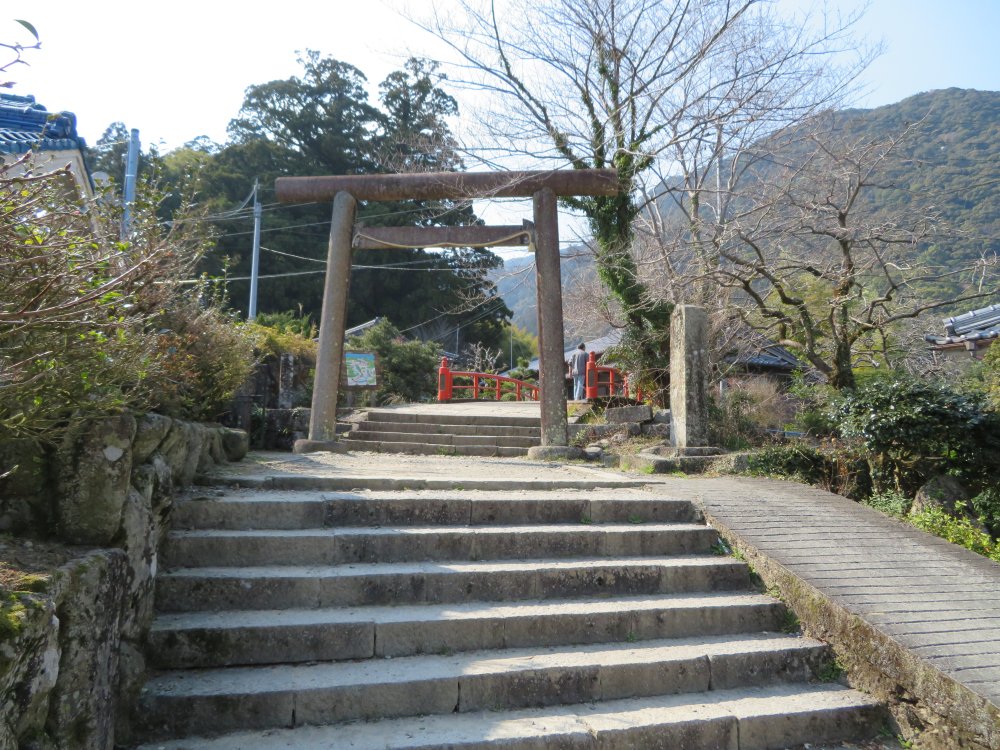
From Daimonzaka we walked the pilgrimage path to the entrance gate and bridge separating the secular world from the sacred.
Our bus dropped us at the car park on the national road close to the entrance to Daimonzaka. A short walk along the old pilgrimage route brought us to the entrance gate to the sacred area of Nach-taisha. Just before that there was a Chaya (tea shop offering food and drinks to the travelers) where you can rent Heian era costumes. We were told that this has become very popular among the youngsters. We later noticed some young ladies in costume waiting at the bus stop in front of the Nachi Waterfall. We went past the entrance gate to enter into a stony passage leading up to the Nachi-taisha. We thought it was no wonder that our ancestors believed the Kii Mountain area as sacred as the moment we entered this passage the air seemed fresher and it was so serene.
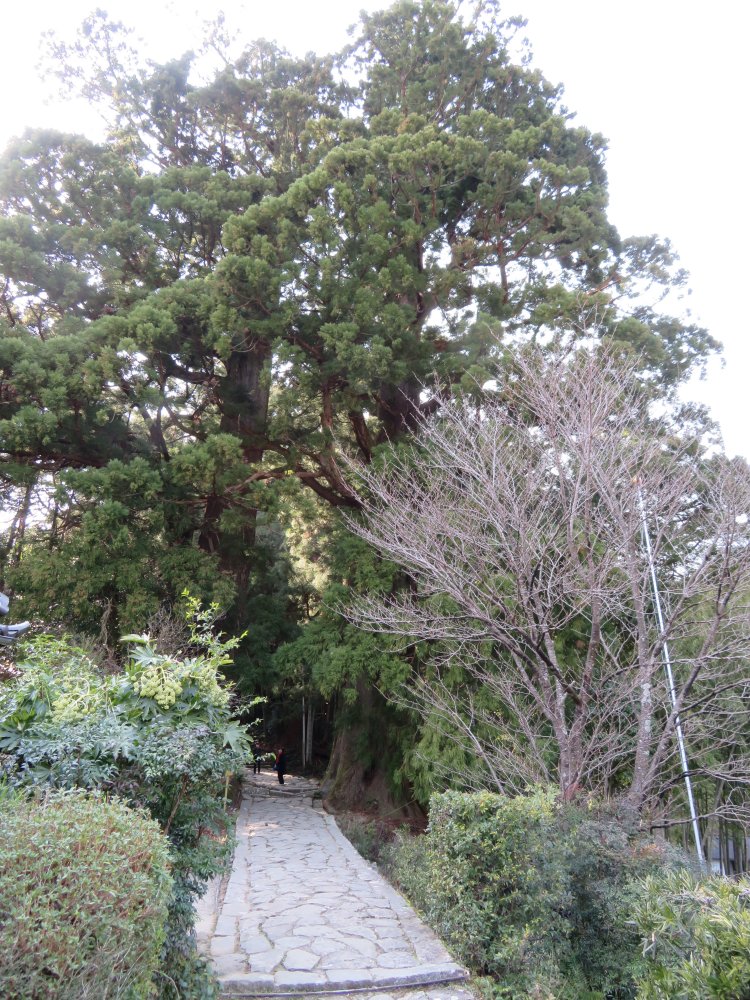
Once you go past the bridge two pine trees thought to be over eight thousand comes into sight. The pine trees are called Meotosugi (husband and wife pines).
Due to time constraint, we left the path after a few hundred meters’ walk
and was picked up by our bus and taken to the car park in front of Nachi
Waterfall. From there we went down the path, and after a short walk reached
the viewpoint of the waterfall. As explained before, our ancestors believed
that the Gods dwell in natural objects such as huge boulders and waterfalls.
The area is part of Hirou Shrine. There is no main shrine as the waterfall
itself is the deity. We paid a modest 300 yen admission fee to go up to
a higher viewing and praying spot. Nachi Waterfall is regarded as one of
the three grandest waterfalls of Japan together with Fukuroda Waterfall
in Ibaraki and Kegon Waterfall in Nikko. Our guide was apologetic that
the waterfall had less water than usual due to a drier winter, although
we still thought it was grand enough for us to understand how it became
revered to be a sacred spot.
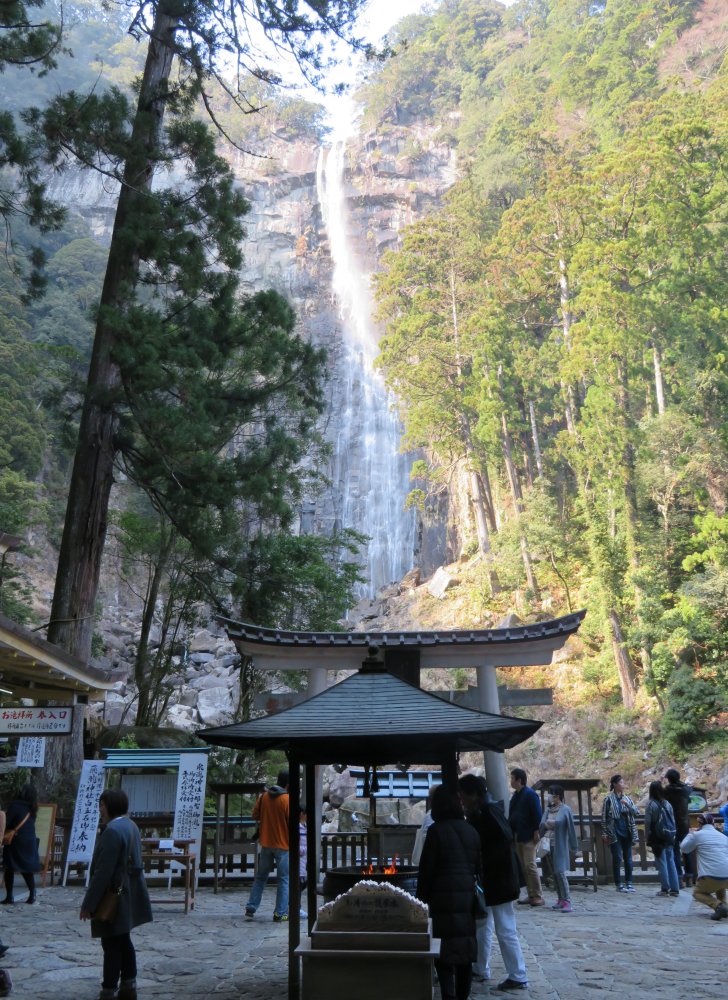
Visitors purify themselves with the river water.
The last place for us to visit on the second day of our tour was Nachi-taisha. We had to climb close to 500 stone steps to finally reach Nachi-taisha. There were many gift shops on our left as we went up. Many were selling Nachi-guro (Nachi Black). This is a hard black slate from the Kii Mountains, that is shaped into the black pieces of Go, inkstones and other black ornaments. Nachi-guro may also be found in some Japanese gardens. I recall my father was very proud of his black Go pieces made of Nachi-guro.
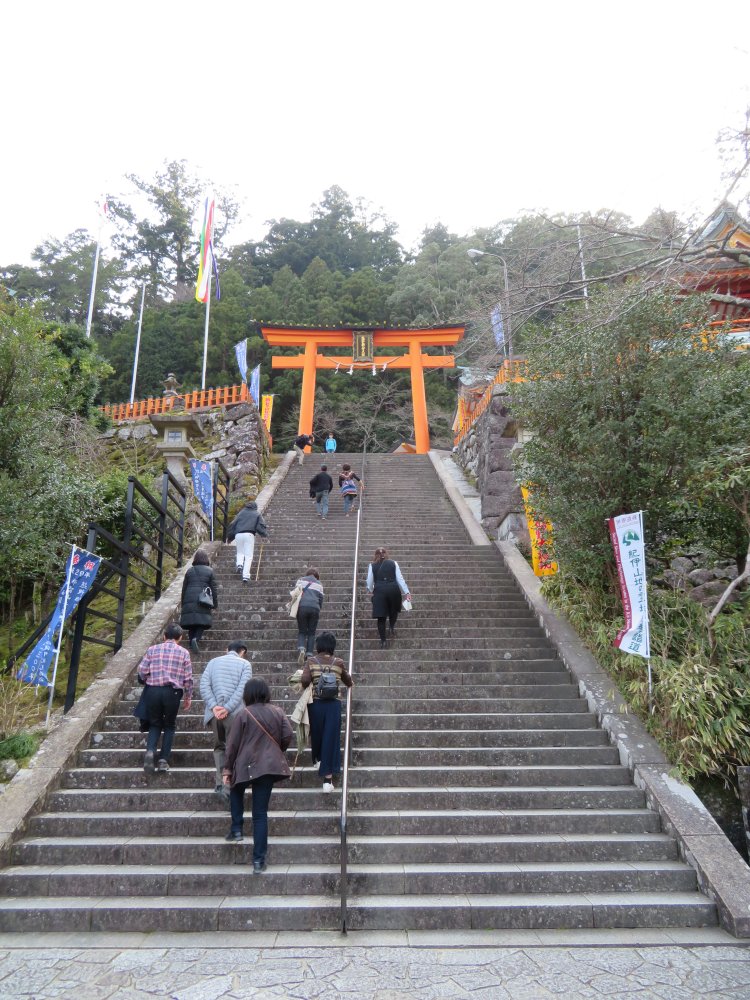
Visitors appraching the end of the climb to Nachi-taisha
The deity worshipped in Nachi-taisha is the Goddess Fusumi who is believed to be Goddess Izanami, the mother of Goddess Amaterasu that is worshipped in Ise-jinguu. I explained in Part 1 that some believed that the Buddhist paradise (Joudo) existed in the Kii Mountain range or further south in the Pacific Ocean and combined with the Shinto belief that some ancient Gods of Japan transcended to the Kii Mountains created a unique Shinto and Buddhism fusion, in this region. As Buddhism spread further in Japan in the Heian era (8th to 12th century), it is easy to imagine people were concerned about the Japanese Gods they had been worshipping. An interpretation called Honchisuijaku was devised that taught that the many Gods of Japan were incarnations of the Buddhist holy figures, in other words that the Buddhist holy figures took the shape of Japanese Gods to manifest themselves. This must have made it easier for people to take up Buddhism as it would not mean abandoning their Gods. Hence, Goddess Fusumi is regarded as the incarnation of Senju-kannnon (thousand-armed Avalokiteshvara). Likewise God Hayatama believed to be Izanagi, the father of Goddess Amaterasu but at the same time is an incarnation of Yakushi-nyorai, and the deity of Kimano-honguu that we visit later is God Susanoo, the younger brother of Goddess Amaterasu and also the incarnation of Amida-nyorai. Senju-kannnon, Yakushi-nyorai and Amida-nyorai are all Buddhist holy priests that lead ordinary folk to paradise. Senju-kannnon has a thousand arms to reach out to save people, Yakushi-nyorai has medicine to cure and Amida-nyorai uses wisdom to save.
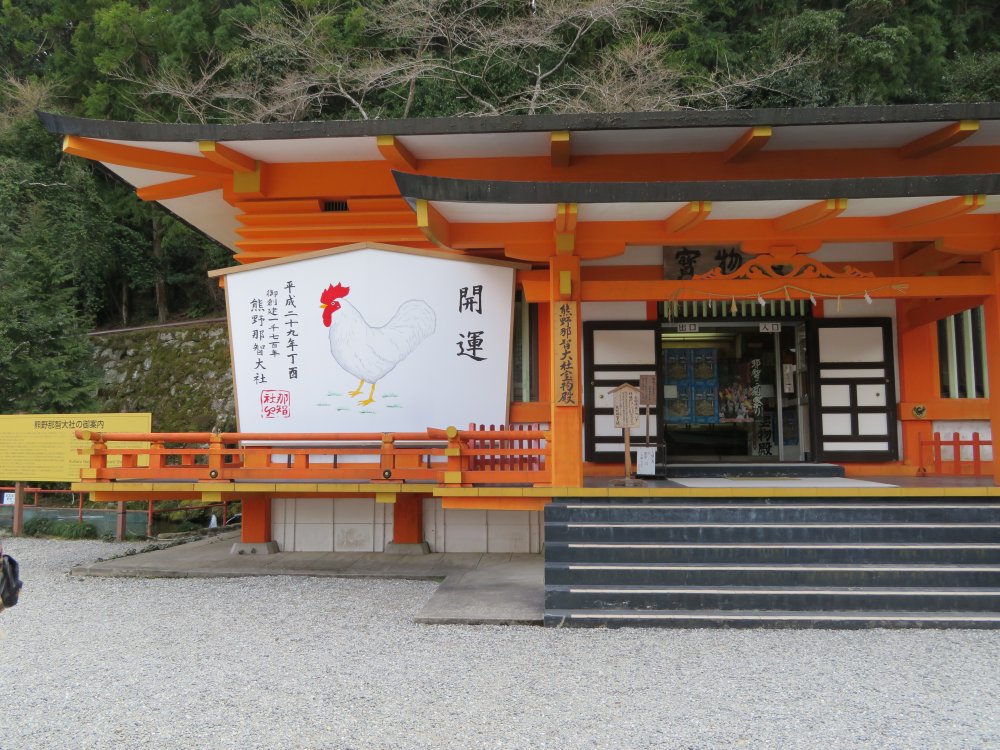
The Treasure shrine of Nachi-taisha. Unfortunetely we had to skip visiting.
I found a statue of Yatagarasu beside the Honden (main shrine). Yatagarasu is the mythical three legged crow that guided the first mythical Emperor Jinmu from Kumano to Yamato (Nara area). Yatagarasu is believed to be a messenger of God Susanoo. It is a quite popular character in the Yoshino (Nara Prefecture) and Kumano region, so much so that there is a sake brand called Yatagarasu brewed in Yoshino.
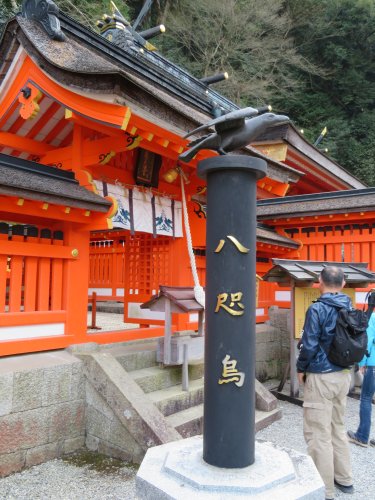
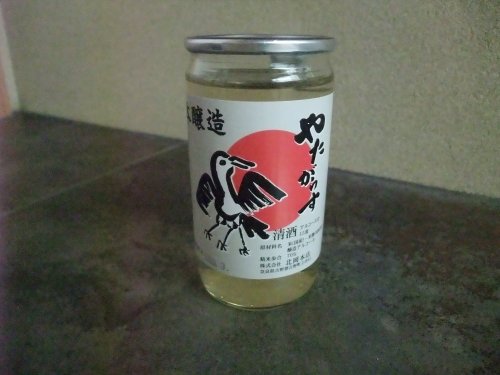
The statue of Yatagarasu beside the honden (left) and a 180 milliliters bottle of Yatagarasu honjouzou brewed in Yoshino (right)
Sitting next of Nachi-taisha but on a slightly lower level is a Buddhist temple of the Tendai sect Seigantoji Temple. With the fusion of Shinto and Buddhism, it was not unusual for Buddhist temples to sit side by side to Shinto shrines. But in the Meiji era as Shinto became the prominent religion in Japan, many Buddhist temples were destroyed. Originally all three of the Kumano Sanzan had accompanying Buddhist temples, but have been lost with the exception of Seigantoji Temple. The hondou (main building) is from the pre Edo era of the late 16th century. In the late Heian era as the belief that the end of the world was approaching, the custom of burying Buddhist text manuscripts arose. From a burial place within the temple grounds many Buddhist statues from the Heian era were excavated. One statue has been identified as coming from the Nara (8th century) era, which is proof that the temple has existed here from at least that time. From the temple grounds one can enjoy a spectacular view of Nachi Waterfall and the surrounding mountains.
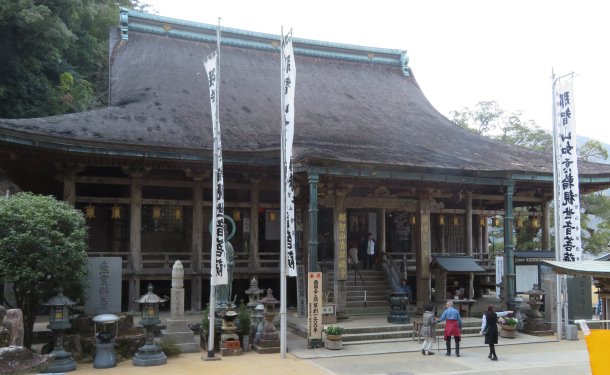
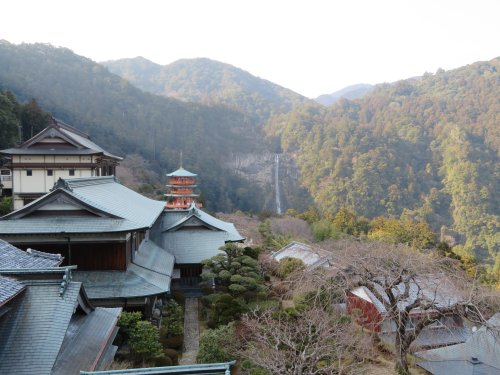
Seigantoji Temple (left) and view of Nachi Waterfall from the temple grounds (right)
It was getting late in the afternoon and our bus took us to our ryokan hotel close to the port of Katsuura. Katsuura or Nachi Katsuura to differentiate the town from Katsuura in Chiba Prefecture is famous for a couple of reasons. It is one of the largest tuna fishing ports and has a natural onsen (hot spa).
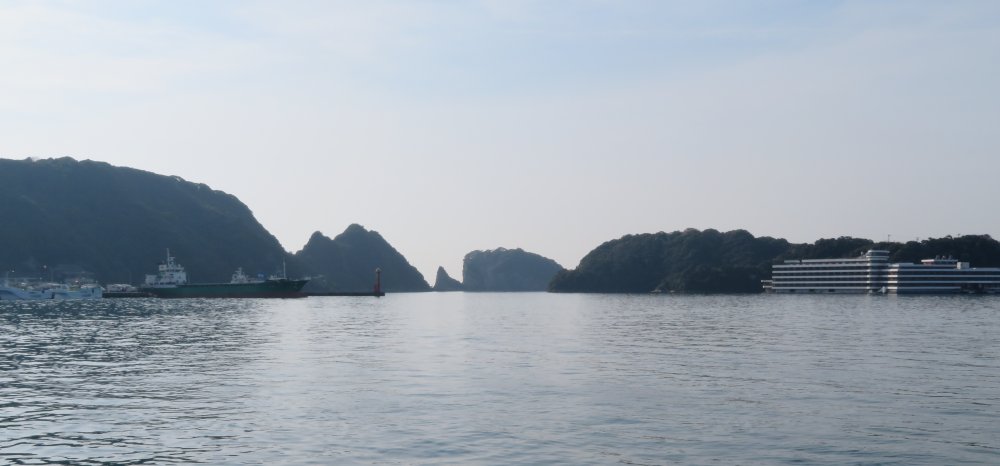
The picturesque view from Katsuura Ferry Pier
We decided to explore the town center of Katsuura and do some shopping before taking a dip in the onsen. Although it was a Sunday, some shops were open in the shopping arcade near the station. I entered a gift shop where I bought pickled plums and two 180 milliliters cup of local sake. Pickled plums go well with steamed rice and are a specialty product of Wakayama alongside oranges. I asked the shoplady if she knew where I could purchase local sake in larger quantities. She kindly took me out of the shop and pointed to a liquor shop further down the arcade. I purchased a 1.8 liters bottle of Taiheiyou (Pacific Ocean). I understand that the sake brewery making the sake using spring water from the Kumano area is the only brewery that remains in this area.
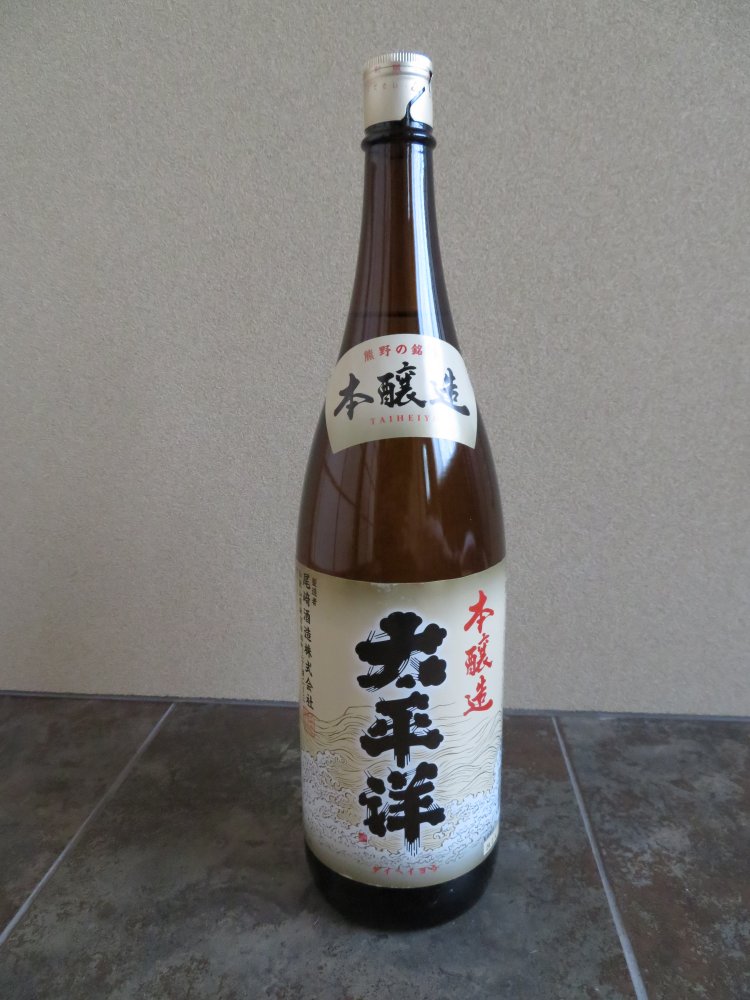
A 1.8 liters bottle of Oimidori honjouzou